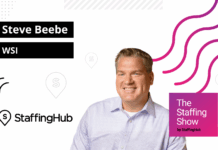
Key takeaways:
- Start with an honest assessment, then stack‑rank initiatives by impact vs. effort so quick wins fund the harder work.
- Automation and AI deliver measurable gains (faster placements and higher revenue) when paired with clean data and change management.
- Budget in phases, blend internal capability with trusted vendors, and set realistic timelines by project type (from 30-60 days for quick wins to 9-18 months for platform overhauls).
What digital transformation means in staffing
In staffing, digital transformation isn’t just about shiny new tools. It’s a business redesign that uses technology to scale the candidate, client, and recruiter experience across the front office (sourcing, sales, delivery), middle office (compliance, time/bill), and back office (payroll, finance). A practical definition:
Digital transformation for staffing is the systematic modernization of workflows, data, and decisions to increase fill speed, redeployment, and margin, at lower cost‑to‑serve.
Key elements include:
- Unified data across your applicant tracking system (ATS), customer relationship management (CRM), vendor management system (VMS), and pay/bill systems.
- Automation of repetitive work (candidate nurture, submittals, interview scheduling).
- AI assistance for search and match, content generation, and forecast insights, all governed by policy.
- Change management that helps recruiters adopt new ways of working (training, incentives, coaching).
Why now? Technology investment is rising even amid uncertainty: global IT spending is forecast to grow 7.9% in 2025, with 62% of CEOs saying AI will define competitive advantage for the next decade.
Phase 1: Measure maturity and surface gaps
A clear baseline lets you prioritize with confidence. In two to four weeks, run this lightweight assessment.
Map the core journeys: Map the candidate journey from sourcing and screening to submittal, interview, offer, onboarding, and ultimately redeployment. Map the client journey through lead generation, qualification, job intake, delivery, and account growth.
Inventory the stack: List systems (ATS, CRM, VMS, background check, e‑signature, time capture, payroll, business intelligence, etc.), integrations, and manual “shadow IT” (spreadsheets, email templates).
Score maturity (1-5) across five lenses:
- When assessing processes, consider whether they are clearly documented, consistently followed, streamlined to remove unnecessary steps, and automated wherever possible.
- Evaluate your data for accuracy, completeness, and accessibility. Determine whether master data management practices are in place to maintain a single, reliable source of truth.
- Review your tech stack for usability and reliability, and confirm that your systems support open application programming interfaces (APIs) to enable seamless integration.
- Assess your people: their skills, adoption of digital tools, and the incentives in place to encourage consistent, high-quality use of technology.
- Finally, examine your governance and risk practices to ensure strong security, regulatory compliance, and auditability across all digital systems and workflows.
Benchmark the numbers: When measuring success, focus on key performance indicators (KPIs) such as time-to-submit, time-to-fill, submittals-per-hire, and the interview-to-offer ratio. Also track your redeployment rate, gross margin percentage, and recruiter productivity, such as the number of viable submittals generated each week.
Find bottlenecks and costs: Where does work pile up? What is the cost/time per placement? Which manual steps create errors or write‑offs?
Pro tip: Be honest about data quality. For many firms, data issues are the most significant barrier to successful AI implementation. So fix the foundation as you modernize.
Phase 2: Build a simple priority matrix
Use a straightforward impact-versus-effort matrix to determine which initiatives to tackle first. The examples below reflect common staffing workflows and can help you decide where to begin.
High impact / low effort (start here)
- Implement automated candidate nurture campaigns via your applicant tracking system (ATS) to re-engage silver medalists and past contractors through personalized email and SMS communication.
- Introduce structured job-intake forms and standardized submittal templates that enforce required fields, reducing unnecessary back-and-forth with hiring managers.
- Adopt e-signature tools to handle contracts and onboarding packets efficiently, eliminating manual paperwork.
- Set up self-scheduling links for interviews and recruiter screens to streamline calendar coordination and reduce administrative delays.
High impact / medium effort (phase next)
- Deploy search-and-match automation using AI-assisted Boolean searches and profile enrichment features integrated within your ATS.
- Automate offer and compliance processes, including document generation and verification workflows, to ensure speed and accuracy.
- Build or integrate client-facing analytics dashboards within your customer relationship management (CRM) system to monitor coverage, fill ratios, and time-to-submit by account.
High impact / high effort (plan carefully)
- Undertake a full ATS or CRM replacement or a major system re-implementation when current tools no longer meet business needs.
- Modernize middle- and back-office operations, such as time capture, pay/bill processes, and commission management, to improve accuracy and scalability.
- Develop an enterprise data platform that consolidates all business data into a governed warehouse with role-based business intelligence access and reporting.
Medium impact / low effort (supplementary improvements)
- Enable automated job distribution across multiple job boards, optimize your career site for conversions, and launch referral portals to increase candidate engagement.
- Standardize call logging and recruiter note-taking practices to create cleaner data pipelines and more reliable reporting.
Why lead with automation and AI? Our 2025 State of Staffing Report found that staffing agencies with revenue growth of 21% or more were more likely to automate processes to boost efficiency, plan new software and technology purchases, and lean on AI for revenue-generating functions.
Budget planning: Approaches and typical investment ranges
How to plan
- Take a top-down budgeting approach that aligns directly with your strategic goals, such as reducing time-to-fill by 25% or redeploying 5% more contractors, rather than starting with a list of specific tools to buy.
- Phase your funding so that early quick-win initiatives can generate savings and operational efficiencies that help self-fund later, larger waves of transformation.
- Treat the total cost of ownership holistically, including not only software licenses but also integrations, data cleanup, security, training, and change-management activities. These supporting costs often account for 15% to 25% of the overall budget.
Practical ranges for mid‑market staffing firms
(approximately 50-500 internal users; actual costs will vary by complexity and vendor)
- Quick-win automation pack: Initiatives such as nurture campaigns, scheduling tools, templates, and light robotic process automation typically require $20,000 to $75,000 for one-time setup and $2,000 to $8,000 per month in ongoing subscriptions.
- Front-office modernization: Configuring your ATS or CRM systems, optimizing workflows, and building integrations may cost $100,000 to $350,000 for implementation, with a monthly run-rate of $15,000 to $50,000.
- Middle- and back-office upgrades: Modernizing systems for time capture, pay/bill processing, and commission management often ranges from $150,000 to $500,000 for implementation, with ongoing costs depending on transaction volume.
- Data and business-intelligence foundation: Establishing a data warehouse, building reporting models and dashboards, and implementing governance usually requires $50,000 to $200,000 upfront and $2,000 to $10,000 per month for maintenance.
- AI pilot programs: Testing and scaling tools like search agents, automated screening, or AI-powered content copilots typically cost $10,000 to $50,000 for the pilot phase and $50,000 to $200,000 per year once fully deployed.
Build internal capability vs. rely on external vendors
When to buy
- Purchase commodity capabilities such as your ATS, CRM platform, VMS connectors, e-signature tools, background check services, and payroll systems rather than building them in-house.
- When evaluating these solutions, look for open APIs, flexible data export options, and transparent product roadmaps to ensure long-term adaptability and reduce dependency on any single vendor.
When to build (or co-build)
- Consider building or co-building solutions only when they create a differentiated experience that provides a competitive edge.
- Examples include proprietary matching models that leverage your firm’s unique talent graph, custom client portals that offer distinct service-level agreements (SLAs), or specialized rate and markup engines that support your unique pricing models.
- Commit to building only if the solution establishes a true competitive moat and your team has the ongoing capability and resources to maintain and evolve it.
A hybrid approach that works
- Establish a small automation and data center of excellence consisting of one product owner, one to two business analysts, one system administrator or architect, and part-time or fractional data engineering support.
- Engage systems integrators for heavy implementation or data migration work, but keep product ownership in-house so that institutional knowledge and process expertise remain within your organization.
- Always include data portability and exit clauses in your vendor contracts to protect your firm from long-term lock-in and ensure flexibility as your needs evolve.
Putting it all together
- Assess (people, process, data, tech, governance) and baseline your KPIs.
- Prioritize with an impact/effort matrix that favors automation, AI‑assisted search/match, and data hygiene.
- Budget in phases with a self‑funding mindset, and include change management and data cleanup.
- Deliver in 90‑day waves, measuring adoption and business outcomes at each step.
- Scale what works, retire what doesn’t, and keep your data clean because it’s the fuel for every gain that follows.
Remember, even strong tech underperforms without adoption. Tie new tools to a single source of truth, make usage effortless in the recruiter’s daily flow, and reinforce with coaching and incentives to ensure new technology can deliver on its promises.
FAQ for staffing leaders
Q: We have a limited budget. Where should we start?
A: Start where impact is high and effort is low: automated nurture for past candidates, structured job intake, e‑signature, and interview scheduling. These reduce time‑to‑submit immediately and free capacity to fund the next phase.
Q: What KPIs matter most for digital transformation?
A: Time‑to‑submit, time‑to‑fill, submittals‑per‑hire, interview‑to‑offer ratio, redeployment rate, fill ratio, gross margin percentage, cost‑to‑place, and recruiter productivity (e.g., viable submittals per week). Track by team and by client.
Q: How do we get recruiters to adopt new tools?
A: Co‑design with top billers, embed tooling in the ATS, provide side‑by‑side coaching for two weeks post‑go‑live, align compensation/scorecards to the desired behaviors, and publicize early wins.
Q: How do we manage data privacy and risk with AI?
A: Use data minimization and retention policies, restrict access to personally identifiable information, sign a robust data processing agreement, and set AI guardrails, such as human review for candidate communications and no automated decisions without transparency.
Q: How do I decide between build or buy?
A: If it’s a commodity and vendors have strong roadmaps and APIs, buy. If it’s a true differentiator that relies on your unique data/process, consider building, but only with committed product ownership and support capacity.
Q: What’s a realistic payback period?
A: Quick‑win automations can pay back in 3-6 months via reclaimed recruiter time and higher fill rates. Platform overhauls typically require 12-24 months to realize full benefits due to data migration and adoption curves.





